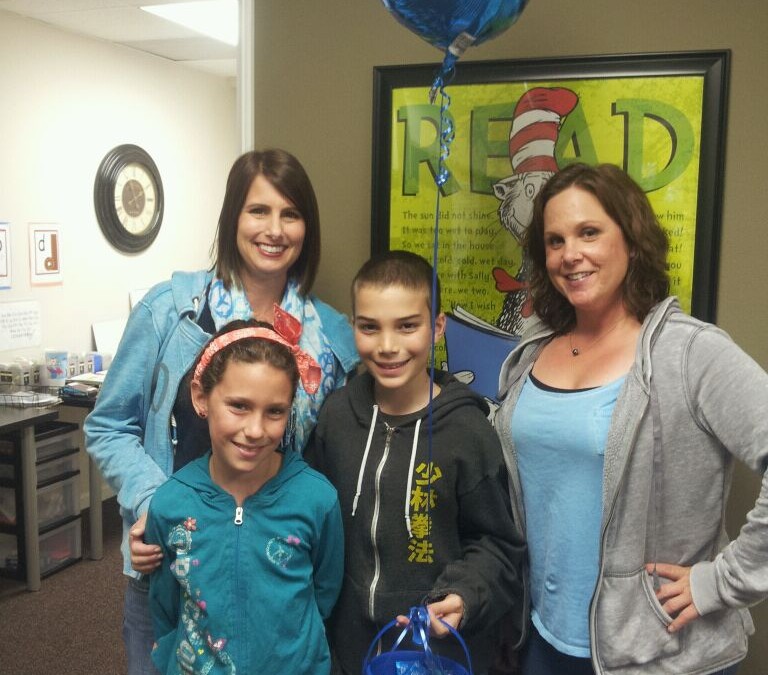
by PRIDE Reading Program Admin | Mar 30, 2015 | Articles & Resources, Autism
PRIDE Learning Center will help raise awareness for autism by participating in the “Light it Up Blue” campaign beginning April 2, 2015.
On April 2, 2015, Autism Speaks, the world’s leading autism advocacy organization, promotes their annual event called Light it Up Blue. This is a global initiative that kicks-off Autism Awareness Month. In honor of this day, many iconic landmarks, hotels, sporting venues, concert halls, museums and retail stores are among the many communities that take part in Light it Up Blue. Autism Speaks is dedicated to funding research into the causes, prevention, treatments and a cure for autism.
PRIDE Learning Center, will help raise awareness by participating in the Light it Up Blue campaign. All four PRIDE Learning Centers will be decorated in blue with displays and handouts about autism on Thursday, April 2, 2014 and there will be blue treats for the entire community. In addition, the employees at PRIDE Learning Center will be dressed in blue.
“We support the Light it Up Blue campaign,” says Karina Richland, owner of PRIDE Learning Centers. “We want to help increase the awareness of Autism Spectrum Disorders and advocate for the needs of individuals with autism and their families” says Richland.
Autism statistics from the U.S Center for Disease Control and Prevention (CDC) identify around 1 in 88 American children as on the autism spectrum. Studies also show that autism is four to five times more common among boys than girls. An estimated 1 out of 54 boys and 1 in 252 girls are diagnosed with autism in the United States.
“We are so pleased and excited to participate in this event to bring autism awareness to the forefront and show that we at PRIDE Learning Center support research efforts to bring an end to this epidemic,” says Richland.
PRIDE Learning Center has four locations in Redondo Beach, Newport Beach, San Clemente and Mission Viejo. For more information visit the PRIDE Learning Center website at www.pridelearningcenter.com or call 866-774-3342.
by PRIDE Reading Program Admin | Feb 6, 2015 | A PRIDE Post, ADHD, Autism
Well, it depends…
The scientific literature abounds with studies claiming to have discovered evidence one way or the other. This often contradictory information can be confusing, but some themes seem to be consistent, and more importantly, to make sense.
For example, there is some correlational evidence that violence in video games may increase aggression in certain vulnerable kids. We believe that kids with excessive anger are attracted to violent games. For these kids, violent games may teach unhealthy conflict resolution skills, glorify aberrant or subversive lifestyles, or desensitize kids to terrible events. Parents should be particularly concerned if a child’s level of aggressive behavior is consistently higher after playing.
On the flipside, there is also evidence that playing video games can act as a healthy outlet for aggressive impulses. Kids who play video games often say that the games help them relax or cope with stress. Violent video games might offer an alternative outlet for aggressive and angry feelings by providing a vicarious, and less destructive, experience of testing limits. In addition, gaming can build self-esteem, provide a sense of accomplishment, and improve socialization. It is unusual, for boys in particular, to not play video games. The shared experience of overcoming certain gaming challenges acts to help some children bond. Game play is often a normal social activity for boys, and lack of interest in social gaming may signal social difficulties.
So if all of this is true, how should parents manage video games in their child’s life? I believe that, for most children, a balanced approach is best. Many kids can use video games in moderation as a healthy tool in their play toolbox. Some children will need their parents to provide structure and moderation for them. For these kids, it is best to make the limits very clear. Parents may want to place a time limit on the game, or a contingency like “you may play for 1 hour after all of your homework and chores are done.” I would also suggest that parents actually play video games with their child. This provides many benefits, not the least of which is forging a stronger bond with your child.
You can also use the time to guide and mentor your child in his or her play. Explain situations or themes that he or she may not understand, or might misinterpret. Use the opportunity to discuss morals and values; parents often underestimate the impact of their words and actions on their child’s beliefs. There are currently several games offering, as a central theme, the moral development of the main character (Fable, Infamous, etc). Use these games as a launching point for discussions about morals.
Playing games with your child also affords you the benefit of a first hand look at the content of your child’s game. Parents can also refer to each games rating from the ESRB (Entertainment Software Rating Board) for a rough guide to a game’s content. Pay particularly attention to games rated “M” as these are intended for people age 17 and above. Your game console, or computer, should have the ability to restrict certain types of games based on that game’s rating.
These suggestions are general, and should work well for most people. For children with significant behavior or emotional problems, the decision to use or exclude video games should be made carefully with attention paid to the potential risks and benefits such a move would have. Allowing the child to use video games, particularly violent games, may increase their aggression, while forbidding the use of their game could remove one of the child’s only sources of self-affirmation and competence.
Some parents have complained to me that their child seems “addicted to their video game”. They spend an excessive amount of time playing alone, and even ignore fun and engaging alternatives. They may not even enjoy playing the game that much, instead they use it to escape from pain or conflict in their lives. In many of these cases, the issue is not the video game itself, but rather the child’s inability to use alternate coping strategies to manage emotional or social problems. If you suspect that your child is suffering from problems like these, I suggest seeking help from a professional in children’s mental health.
Stephen Morris, M.D.
Doctor Morris is an Adult, Child, and Adolescent Psychiatrist operating a private practice in Manhattan Beach, California. For more information, please contact him through his website at https://www.StephenMorrisMD.com

by PRIDE Reading Program Admin | Jul 8, 2014 | A PRIDE Post, Autism, Reading Comprehension
Reading comprehension help for students with autism may requires a few strategies that YOU the parent or teacher can easily do at home or in the classroom. Studies consistently show that children who are encouraged to use visual imagery have improved performance on tests of comprehension and recall of materials. For many children with autism, this skill of using mental imagery in text is an extremely challenging task. Nevertheless, this method can be taught and mastered.
Reading Comprehension help for students with autism involves VISUALIZATION. This is one of the most effective ways to help improve reading comprehension in a child with autism. How do you teach this? Well …. try to encourage the child to form mental pictures of the events described in the stories read.
TEACHING VISUALIZATION…
An autistic child struggling with reading comprehension will benefit from a teaching method geared to make sure that he understands and thinks about word meaning as he reads and that provides a specific scheme for visualizing. For example, a teacher might stop a student after reading a few lines and encourage the student to form a mental picture with a question such as “what do you think that looked like?” This allows the student to build imagery directly related to the concepts conveyed in the reading and at the same time to continue to focus on the printed symbols on the page.
- Use prior knowledge and pre-reading strategies. “Look at the title. Think about what the story might be about.”
- For stories, the student can visualize what is happening at the beginning, middle, and end of the story. “Read or listen to the first few sentences. Remember to get a picture in your head for each sentence. Do not continue until you get a moving picture in your head, kind of like a movie.”
- For informational text, student can think about key words and visualize the content they are learning. “Read or listen to this paragraph. Remember to get a picture for each sentence. Ask me if you do not understand a word.”
- Students should be asked to explain their images. “Can you describe what you see as you are reading.”
- Students should compare the picture in their minds with what they are reading. “Tell me as much information as you can remember.””
Integrating the child’s own artwork with story reading, such as having the child draw a map or diagram of events, or represent the story in cartoon form, is also useful. They can also read an entire passage and then create an illustration that represents the main idea of the paragraph. To help the child decide which ideas are most important, provide them with some guidelines: “If this story were to be made into a movie, which scenes absolutely must be included for the story to make sense. Which scenes would be funny, sad, etc.”?
Reading Comprehension help for students with autism involves your help and guidance in teaching visualization strategies. Good Luck – and let us know how they worked!
__________________________________________________________________________________________________

Karina Richland, M.A. is the Founder of PRIDE Learning Centers, located in Los Angeles and Orange County. Ms. Richland is a reading and learning disability specialist and speaks frequently to parents, teachers, and professionals on learning differences. You can reach her by email at karina@pridelearningcenter.com or visit the PRIDE Learning Center website at: www.pridelearningcenter.com

by PRIDE Reading Program Admin | Mar 20, 2014 | Autism
On April 2, 2014, Autism Speaks, the world’s leading autism advocacy organization, promotes their annual event called Light it Up Blue. This is a global initiative that kicks-off Autism Awareness Month. In honor of this day, many iconic landmarks, hotels, sporting venues, concert halls, museums and retail stores are among the many communities that take part in Light it Up Blue. Autism Speaks is dedicated to funding research into the causes, prevention, treatments and a cure for autism.
PRIDE Learning Center, will help raise awareness by participating in the Light it Up Blue campaign. All four Learning Centers will be decorated in blue with displays and handouts about autism on Wednesday, April 2, 2014 and there will be blue treats for the entire community. In addition, the employees at PRIDE Learning Center will be dressed in blue.
“We support the Light it Up Blue campaign,” says Karina Richland, owner of PRIDE Learning Centers. “We want to help increase the awareness of Autism Spectrum Disorders in the Orange County and Los Angeles communities and advocate for the needs of individuals with autism and their families” says Richland.
New autism statistics from the U.S Center for Disease Control and Prevention (CDC) identify around 1 in 68 American children as on the autism spectrum. Studies also show that autism is four to five times more common among boys than girls. An estimated 1 out of 42 boys and 1 in 189 girls are diagnosed with autism in the United States.
“We are so pleased and excited to participate in this event to bring autism awareness to the forefront and show that we at PRIDE Learning Center support research efforts to bring an end to this epidemic,” says PRIDE Learning Center owner, Karina Richland.
PRIDE Learning Center has four locations, San Clemente, Mission Viejo, Newport Beach and Redondo Beach, Ca. For more information contact PRIDE Learning Centers at 866-774-3342 or visit the website https://www.pridelearningcenter.com

by PRIDE Reading Program Admin | Feb 22, 2011 | A PRIDE Post, Auditory Processing Disorder, Autism
Many of our students at Pride Learning Center have been diagnosed with auditory processing difficulties due to CAPD, ADHD, dyslexia, autism, or a learning disability. Often parents will ask me the question, “what can I do at home to help?” I have composed a list of activities that strengthen and support auditory processing deficits that are simple, quick and easy to incorporate at home.
a
1. Listen for Sounds. Have your child sit at your desk, close their eyes and identify sounds that you make. You can drop a pencil, bounce a ball, tap on the window, tear a paper, use a stapler, cut with scissors, open the door, type on your computer, sip a cup of coffee or write with a marker. Trade roles and then let the child make different sounds that you have to identify.
2. Take a Nature Walk. Sit outside under a tree and listen for various sounds outside of the house. Sounds like birds chirping, airplanes flying overhead, cars driving by, voices of children playing are fun to identify. You can have a little notebook on hand and keep a list of all of the different sounds you came across.
3. Repeat a Pattern. Sit across from your child and clap your hands to a rhythmic pattern alternating between slow and fast tempos. Have your child repeat the pattern. You can also use various instruments, play a drum or bounce a ball to a variety of rhythms. Switch roles and let your child be the sound leader as well.
4. Hide and Seek. Hide a metronome or a ticking clock somewhere in your home. Have your child find it by locating the sound. Another variation of this game can be played outside. You can hide somewhere and blow a whistle. The child will then follow the sounds to find where you are hiding.
5. Sing Songs. Sing songs together that involve repeating previous verses, such as “Old MacDonald Had a Farm”, “Over in the River”, “The Twelve Days of Christmas” and “The Green Grass Grows All Around.”
6. Read Rhyming Books Together. For beginning readers, repetitive and rhyming books help children listen carefully to the similar sounds of rhyming words. Some great rhyming books are “Hop on Pop”, “Fox in Socks”, “Goose on the Loose” and “Goodnight Moon.”
____________________________________________________________________________________
Karina Richland, M.A., E.T. is the Managing Director of Pride Learning Centers, located in Los Angeles and Orange County. A former teacher for Los Angeles Unified School District, Ms. Richland is a reading and learning disability specialist. Ms. Richland speaks frequently to parents, teachers, and professionals on learning differences, and writes for several journals and publications. You can reach her by email at karina@pridelearningcenter.com or visit the Pride Learning Center website at: www.pridelearningcenter.com
by PRIDE Reading Program Admin | Dec 16, 2010 | A PRIDE Post, ADHD, Autism
Learning Disability and Gifted?
Gifted children with learning disabilities are known as “twice exceptional.” In the educational system a child labeled both “gifted” and “learning disabled” is rare. Most children are labeled as either remedial and special needs or honors and college prep. Rarely are these children viewed as a combination of the two. Most educators do not expect a gifted child to have dyslexia or even realize that a child with ADHD (attention deficit disorder) might also be brilliant in creative writing or calculus. Identifying a child as twice exceptional is very difficult since these children may be compensating for and masking their learning disability, and in turn their disabilities may disguise their giftedness.
I recently read a book titled, Light Up Your Child’s Mind. Dr Renzulli and Dr. Reis write about the crucial role parents and educators can play in their children’s development. They discuss that intelligence; creativity and motivation to achieve can be fostered in bright children, even unmotivated ones. The book provides tips on how to identify and encourage giftedness in children, while still helping the child succeed within the educational system. An entire section is devoted to resources and suggestions on where to go to help your child develop constructive and interesting projects within his or her area of giftedness and interests. These include:
- Mentors-in-print
- Web site enrichment activities
- Contests and competitions
Light Up Your Child’s Mind presents a practical guide for teachers and parents to help their children “light up” a love of learning forever. This is an easy read and is well organized into three different sections:
- What is this thing called giftedness
- Practical paths to developing your child’s gifts and talents
- Special Considerations
Originally, I borrowed the book from the library, but then ended up buying it since I found this chapter on resources to be extremely valuable. I now have the book on my desk so that whenever my students need a stimulating activity to work on I use the book as a reference guide.
Raising a gifted child and developing those gifts requires a parent or teacher that is open minded, flexible and ready to invest the time and effort needed. Gifted children all have unique strengths and interests that should be recognized and developed.
___________________________________________________________________________________
Karina Richland, M.A., E.T. is the Managing Director of Pride Learning Centers, located in Los Angeles and Orange County. A former teacher for Los Angeles Unified School District, Ms. Richland is a reading and learning disability specialist. You can reach her by email at karina@pridelearningcenter.com or visit the Pride Learning Center website at: www.pridelearningcenter.com





